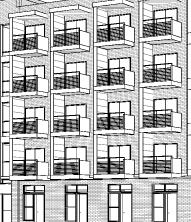PLANNING FOR HOUSING



Housing has been at the forefront of national discourse for the past decade, with persistent challenges affecting everyone, from our largest cities to our smallest villages. Communities everywhere are realizing that housing issues won’t be solved by market forces alone, nor do state or federal governments have the resources to jump in to help.

So, to what extent does local government really need to be involved in housing market planning? And, how can our leaders successfully deliver affordable, quality housing options for residents?
It begins with establishing local policy. Municipalities sometimes feel they have little control over what type of housing is built because they are just responding to what developers propose. The reality is, local governments can — and should — take a leadership role in the evolution of their community’s housing market, proactively guiding not only where new or redeveloped housing is built, but also the type, quality, and range of affordability.
How does a municipal government know what kind of housing suits their community? By listening to their residents and paying attention to where gaps exist. Residents often have needs and preferences that aren’t being met in the local market, whether they are looking for affordable, quality rental units, first-time ownership options, barrier-free design for graceful aging, or flexibility to accommodate shifting household size or composition. Residential structures are among the most longlasting in our communities, and local governments need to respond to emerging needs and trends with equally long-lasting, diverse housing options.
Housing challenges fall into three core topics: cost, supply and quality.
Cost is arguably the most critical and widespread issue facing households today, as costs have been rising quickly and housing was already the largest cost for most American households.
Let’s look at the numbers.

Over the past 60 years, housing costs have been increasing faster than wages across most income brackets. Adjusting for inflation, household income has increased about 30% (due mostly to the increase in two-income households), while rents have increased about 70% and home prices, 120%. The cost of housing has become unsustainable for many individuals and families. People are forced to choose between a larger debt load or compromise their standards for quality or safety in order to simply pay the bills. For a growing number of renters, home ownership is an unattainable goal.
Meanwhile, the cost of construction continues to rise. Labor shortages, increased land cost, and materials all impact the bottom line in either building new or remodeling existing homes. This places additional strain on community leaders who have a critical need to develop new housing, yet struggle to strike the balance between quality and affordability— sometimes feeling that they are choosing one over the other.
Housing demand is high, and supply hasn’t kept pace. The United States has been witnessing a slow recovery of the housing market since the Great Recession in 2007-2009. COVID-19, supply chain disruption and inflation have further complicated new home production by increasing costs and slowing construction. While demand for single-unit detached housing remains, there is simply not enough stock to go around, resulting in a persistent “seller’s market” in recent years. This, paired with the persistent cost inflation, has led to a noticeable shift toward long-term renting and attached-unit housing formats such as townhomes and apartments.
Communities need to shift to accommodate these evolving needs, encouraging a wide variety of housing types to satisfy a wide range of incomes. More households with relatively high incomes are also now choosing to rent, and the market has responded with higher-priced units that offer a suite of complementary amenities such as underground parking, pools and exercise rooms.
A critical challenge is that developers and lenders often prefer projects with 100+ units. In some communities, residents object to these proposals based on the building size and the concentration of rental units. We also hear frustration about what isn’t being built — three-bedroom units, affordable units, and/or units in smaller structures that contain 4-10 residences — often known as “missing middle” housing because it refers to everything in between single-unit detached homes and large, 50+ unit buildings.


Taking an annual inventory, conducting a housing study and listening to the evolving needs of constituents will help communities build out or reinvigorate essential housing stock.
Housing quality is in some ways a subjective consideration — people have varying expectations and needs. There is a basic minimum for health and safety set by building codes, but the aesthetic appearance and function of housing is also critical to consider, both in new construction and in older homes and apartments.
When we hear complaints about a lack of affordable housing (and we do hear that in most communities), we understand that most people mean a lack of desirable, affordable housing; they are dismissing the units that are affordable but in declining condition. In many communities across the Midwest, for example, pre-war housing is still a substantial portion of the total housing stock. These aging homes are usually energy inefficient, in need of repairs, and missing amenities that people seek today, such as full-height basements, main floor laundry, or two-car garages.

An important consideration is the peer influence of housing investment (or disinvestment) within a neighborhood. People take cues from their neighbors when deciding whether to reinvest in an aging home or find something better elsewhere.
In new construction there is also a risk of poor quality housing, due to low-cost materials and construction, or design decisions that sacrifice curb appeal or typical amenities to hit a certain price point. The greatest risk is that such housing will not be valued by occupants or the community, discouraging long term maintenance and reinvestment.
Reinvestment in housing over time is critical to having desirable housing options in your market and healthy, attractive neighborhoods.

All of these housing challenges are occurring to various degrees across the country, but the key to success is gaining a clear understanding of individual, local market dynamics and identifying interventions that will be both feasible and effective there. What challenges is your community facing within the housing market? What gaps exist? How do you get started on a plan toward attracting — and retaining — residents for the long term?
First, conduct a housing study. A housing study is the best way to understand the local market and everything affecting it: wider market forces, the condition and mix of housing units, local regulations, employment, geography, citizen demographics and more.
• The purpose of a housing study is to identify actions that can lead to change.
• The process of a housing study involves collecting data and conducting interviews to identify housing gaps and strategize means to close them.
Let’s talk more about the process. At MSA, the two core components of a housing study are data and interviews. We collect data from a variety of local, regional and national sources that describe aspects of housing supply and demand. We also spend time talking to those who know the market best: realtors, lenders, developers, builders, landlords, city staff, social service providers, and — of course —owners and renters. This allows residents and leadership to take a proactive role in guiding the future of their housing stock.
Community input is also essential to our interpretation of the data, either to add context and anecdotal support or, sometimes, to challenge the accuracy or completeness of the available data. It allows us to better understand why there are specific gaps in the market between the supply of housing units and the demand for those units. Then, it allows us to pick strategies to close those gaps that are viable in the community.
Second, employ a housing action plan. A housing action plan is the bookend of a housing study—an implementable guide that outlines any regulatory changes to be aware of, funding sources to pursue and mechanisms with which to pursue them, public outreach and education efforts, and organizational steps to enable the community to take action.
Although all housing studies start with a similar framework, as the process unfolds it becomes clear that every community is truly unique in its condition and needs—and every action plan answers to a different mix of challenges, solutions and timelines.

Let’s take a look at some communities with housing needs or profiles that may be similar to yours.
• Busy tourism community with a high percentage of commuting employees.
• Lack of affordable, year-round housing.
• A desire to transform commuters to residents.
• Building or redeveloping property to serve a wide range of households and incomes.
• Using Tax Incremental Finance tools to support housing affordability and a down payment assistance program for employees who purchase homes in the community.
• Land-banking adjacent undeveloped lots to create a unique pocket neighborhood.
A tourism destination with over $1 billion in direct visitor spending annually, this community had seen large amounts of housing investment since incorporation— but not in the year-round permanent housing market. Employers and community leaders noticed a lag in attracting and retaining employees needed to grow their businesses, seeing their workforce struggle to find suitable and affordable options. This resulted in an employment market where only 5% of employees lived in the community—with many commuting 45 minutes or more.
Through targeted interviews and direct employee and family outreach, MSA identified which housing needs and preferences of this strong and growing workforce were not being met. Beyond a lack of unit types and prices, many indicated a strong desire for a “sense of place”— neighborhoods designed to foster a shared sense of community for families and individuals who wanted to become permanent residents.
The study confirmed city leaders’ initial perceptions about a failure to convert local workers to local residents; it also shed light on another issue: residents currently living in the community were also struggling to find and afford housing. Large mobile home parks had taken the place of the starter-home market and renter households were unable to find the right size and price of units to stay and grow their families.
Recognizing a combination of needs, the community is currently working through several recommendations from the housing study and report. Some of these initiatives include: broad community development that serves a wide range of households and household needs; acquiring certain undeveloped lots to band together for the creation of
a “pocket neighborhood,” which would provide a new sense of place and community; utilizing Tax Increment Financing tools to support housing affordability; and, encouraging a downpayment assistance program for employees who purchase homes in the community—to be led and funded by employers.

Community at a glance:
• College community with common student housing challenges.
• Concern about old housing stock and homes falling to disrepair.
• New development hindered by city ordinances.
While this Midwest college town had been witnessing employment growth due to the success of several large companies in the area, their housing supply and population numbers were not seeing corresponding growth. Much of the existing housing stock was quite old, serving as rental units for the university population. The community expressed widespread concern about its sustainability.

MSA coupled data analysis with a series of interviews — people connected to, or affected by the housing market — including realtors, lenders, corporate directors, the university, community
Housing strategies:
• Targeting both new neighborhood development and strategic infill redevelopment.
• Utilizing funding to acquire and redevelop homes in very poor condition.
• Updating city ordinances to remove barriers to redevelopment.
service providers, City staff, and more. Focus groups were also formed—one with the local business council and another with students at the university. In addition, a community survey about housing conditions, preferences and policy collected over 1,200 responses. Synthesis of this data and stakeholder feedback confirmed that the city was struggling to build new units of all types for a variety of reasons. Residential growth was constrained by natural barriers and the growth of a neighboring community. Infill redevelopment was too often discouraged and complicated by city ordinances, including bans on overnight street parking, a strict limit on the number of unrelated occupants in residential units and a requirement that every single project with attached-unit housing be approved for a conditional use permit.
Meanwhile, the poor upkeep of aging homes was a prevalent and persistent problem—people could find homes
available to buy within their budgets, but many had fallen to disrepair. Too often, these issues caused buyers to simply move on and leave the city in pursuit of homes that didn’t require an upfront investment for upgrades and general maintenance.
MSA’s housing plan advised a host of strategies that the city is currently working on implementing, including: new neighborhood delineation and development; targeted infill development downtown and along key corridors connecting the downtown to the interstate highway; funding to acquire and tear down/make available for rebuild some of those homes in the worst condition; ordinance updates to remove barriers to redevelopment; and continued engagement and enforcement with student renters and landlords to ensure needs are being met.
competitive community.
• Small city at the edge of a larger metropolitan area.
• Most attached-unit housing concentrated near the highway and in declining condition.
• Most single-unit, detached homes are relatively new and high-cost, leaving few options for moderate-income households.
In the 30 years since incorporating to become a city, this former township at the edge of a much larger city had been reluctant to get actively involved in addressing issues like affordability. At the time of incorporation, about two-thirds of city households were renter households in large apartment complexes built near the regional highway. After prioritizing single-unit detached housing development for several decades, the city had a 50/50 mix of owned and rented units. Rentals tended to be multi-unit properties that were relatively affordable, albeit older and of poorer quality. Owned properties were generally single-unit homes, newer in age and with a much higher price tag. The difference between the two was growing, and there were too few options in between.
• Creation of a Housing Committee to lead, educate and facilitate a housing plan.
• Development of programming tools including a revolving loan fund, down payment assistance program, and municipal land assembly.
• Utilization of the Tax Increment Finance Affordable Housing Extension to capture funds that could leverage housing development and close project financing gaps.
Public engagement was a huge and vital component of this particular study. It is common to create a community committee or task force to provide input and oversight during the planning process. The task force for this study stood out in size of representation, consisting of 30 members representing City Planning and Development staff, City Council, Plan Commission, the Community and Economic Development Authority, local developers, local apartment managers, the County Housing Authority, Habitat for Humanity, local lenders, and many other facets of the community.
In addition, MSA organized workshops to solicit feedback from two critical user groups: supply-side users (construction, development and approval personnel) and demand-side users, who could voice
opinions on community needs and the means to close gaps identified in the study.
Based on task force input, user group opinion and a housing gap analysis, several key steps emerged to help this community chart a path forward: the creation of a standing Housing Committee to provide leadership, education, and facilitation; assessment of a cost/benefit in fee reductions and waivers to streamline affordability of development and land use approvals; development of various programming tools including a revolving loan fund, down-payment assistance program, and municipal land assembly; and utilization of the TIF Affordable Housing Extension to capture funds that could leverage development and close project financing gaps.
While market forces are important to account for, communities do have control over many aspects of housing development: land use planning, urban design standards, development fees, project funding assistance, communication and engagement with residents, and partnerships with community organizations.
Charting a path forward starts with deciding that housing is a priority in your community. In many communities, business leaders have become the most prominent housing advocates due to hiring challenges.
Create a plan.
There are likely more gaps and opportunities than you currently realize. A comprehensive assessment can identify those gaps so that you can prioritize and confidently address them. MSA can help develop a toolbox of strategies to make any community’s housing market healthy and resilient in this ever-changing world.